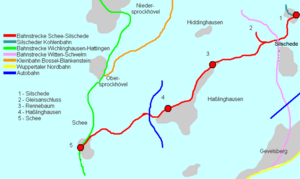Schee – Silschede railway line
| Schee – Silschede | |||||||||||||||||||||||||||||||||||||||||||||
|---|---|---|---|---|---|---|---|---|---|---|---|---|---|---|---|---|---|---|---|---|---|---|---|---|---|---|---|---|---|---|---|---|---|---|---|---|---|---|---|---|---|---|---|---|---|
|
Map of the Schee-Silschede route and adjacent railways
| |||||||||||||||||||||||||||||||||||||||||||||
| Route number (DB) : | 2714 | ||||||||||||||||||||||||||||||||||||||||||||
| Course book section (DB) : | ex 228g (1951) | ||||||||||||||||||||||||||||||||||||||||||||
| Route length: | 9.16 km | ||||||||||||||||||||||||||||||||||||||||||||
| Gauge : | 1435 mm ( standard gauge ) | ||||||||||||||||||||||||||||||||||||||||||||
|
|||||||||||||||||||||||||||||||||||||||||||||
The Schee – Silschede railway line was a nine-kilometer secondary railway line in North Rhine-Westphalia . It ran from the old Sprockhövel customs town of Schee on the Wuppertal-Wichlinghausen-Hattingen railway to the Gevelsberg town of Silschede .
The line was built between 1887 and 1889 and was mainly used to transport coal for the adjacent mines Zeche Deutschland and Zeche Stock & Scherenberg in Haßlinghausen and the United Trappe colliery near Silschede. In 1989 the railway line was finally closed. At the beginning of the 21st century it was converted into a pedestrian and bike path.
history
The construction was requested since 1874 by the community representatives of the Haßlinghausen district under their head August Göbelsmann and the bailiff Wilhelm Becker. Due to the closure of the Haßlinghauser Hütte and the subsequent sales difficulties for local suppliers, including the Germany mine and several iron ore mines , the town found itself in a deep economic crisis, which led to the emigration of a fifth of the population.
Since the only relevant local buyer was no longer available, the sales had to be sought in the distance. Although both mines were among the largest mines in the Ruhr area, they now suffered severely from a lack of transport infrastructure. While the United Trappe colliery still had a connection to the Hasper Hütte via the narrow-gauge Schlebusch-Harkorter coal railway , the Germany colliery was limited to road-bound coal forwarding. Therefore, the mines could only switch to the economically urgent civil engineering after the construction of the railway line . So far, however, there has been no sales opportunity, from which some local quarries and lime kilns have suffered.
The pleadings were finally heard and led to the planning in 1885. The two-and-a-half-year construction began in spring 1887 after the Haßlinghausen office bought up the land for the alignment for 200,000 marks for 200,000 marks - a condition for approval of the construction. Many owners who were not interested in the sale had to be expropriated. The Haßlinghauser collieries contributed another 100,000 marks to the financing. 90 to 100 workers, including many locals, eventually built the route.
The calculation worked. As early as 1890, there was full employment again and the economy swelled. When the colliery died out in 1925, however, freight traffic again lost its importance. Smaller businesses and the Haßlinghauser Glashütte now provided the remaining freight volume. The direction of transport changed, now more goods were transported than shipped.
Passenger traffic to Wuppertal never played a major role. Until 1951, the year passenger traffic was discontinued, sometimes only a passenger car was attached to one of the scheduled freight trains. Depending on the duration of the loading activity at the companies to be connected, unplanned interruptions took place on a journey, so that the railway line was not accepted by the population as a local means of public transport.
The remark on the timetable from 1950: “ Train can depart 30 minutes earlier without notice ” proves that despite two mixed and two pure pairs of passenger trains per working day, the railway did not consider passenger traffic to be too important. In addition, the Haßlinghausen – Wuppertal tram line was an alternative means of transport suitable for the masses and widely accepted by the population.
In 1989 the line was finally closed.
Routing
The 9.16 km long branch line branched off the Wuppertal-Wichlinghausen-Hattingen railway line at Schee station shortly after the city limits of Wuppertal, crossed the later A 43 and led past the site of the former Germany mine along the Sprockhövel districts of Haßlinghausen and Rennebaum to Hiddinghausen . There it crossed under the state road 58 (until January 1, 2008 federal road 51 ) and ran parallel to the B 234 to Silschede. Shortly before its end point, it crossed the Witten – Schwelm railway line , which ran through the Silscheder Tunnel here.
The alignment had no outstanding engineering structures. Several street underpasses, smaller cuttings and dams shaped the course.
Todays use
The branch line to Silschede is now part of the Von-Ruhr-zur-Ruhr cycle path . This has been modified accordingly from Schee to Silschede since 2002/2007/2008 . The cycle path ends in Silschede on the street Auf der Ilberg , a cul-de-sac to the L 527. (Status: October 2008)
Building of the former Schee train station , Sprockhövel- Gennebreck
Cycle path in the area Am Klopwams in Hiddinghausen
literature
- Bernd Franco Hoffmann: Disused railway lines in the Bergisches Land. Sutton-Verlag, Erfurt April 2013, ISBN 978-3-95400-147-7 .
- Karin Hockamp: From steam horse to bicycle - the history of the Schee-Silschede railway line. (PDF) Sprockhövel city archive, May 2003, accessed on December 29, 2012 (93 kB).
Web links
- Description of route 2714 in the NRWbahnarchiv by André Joost
- Description of this sight on the route of industrial culture
- Article on ruhrkohlenrevier.de
- Article on sprocki.de
- Video of the route today
Individual evidence
- ↑ Railway Atlas Germany . 9th edition. Schweers + Wall, Aachen 2014, ISBN 978-3-89494-145-1 .




